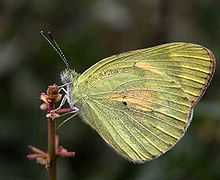Colotis amata
| Small Salmon Arab | |
|---|---|
| | |
| Scientific classification | |
| Kingdom: | Animalia |
| Phylum: | Arthropoda |
| Class: | Insecta |
| Order: | Lepidoptera |
| Family: | Pieridae |
| Genus: | Colotis |
| Species: | C. amata |
| Binomial name | |
| Colotis amata (Fabricius, 1775) | |
| Synonyms | |
| |
The Small Salmon Arab, Colotis amata is a small butterfly of the family Pieridae, that is, the Yellows and Whites, which is found in Asia.
Description
- See glossary for terms used
_on_Lantana_species_W_IMG_1476.jpg)
Male upperside has a salmon-pink ground colour. The costa on the forewing is black and thickly overlaid with greyish or pinkish scales ; a black spot at apex of cell, which may be large and quadrate or smaller and lunate ; termen broadly black, with an enclosed double transverse series of spots of the ground-colour the inner series consists of a large spot in interspace 1, two very small spots in interspaces 2 and 3, one in.each, and four larger anterior spots placed in a curve ; the spots in the outer series are variable in number, but generally there is one in each interspace, these are more or less linear in shape. Hind wing: a band on costal margin extended to just within the upper margin of the cell, covered with dense black specialized scales ; this black band joined onto a broad similarly- coloured terminal band of ordinary scales, that becomes more or less diffuse and powdery posteriorly, and encloses a double series of small spots of the ground-colour the inner series often obsolescent, in some specimens entirely absent; dorsum heavily irrorated with fuscous scales, the irroration extended onto the disc, which has therefore generally a greyish appearance.

Underside : greenish yellow ; an anticiliary fine black line on both fore and hind wings ; the black markings of the upperside show through by transparency. Fore wing : a black spot, variable in size and intensity, in some specimens absent altogether, at apex of cell ; a subterminal quadrate black spot in interspace 1 and another (sometimes faintly marked or absent) further outwards in interspace 2 ; disc faintly, dorsal margin broadly very pale salmon-pink. Hind wing: the whole surface sparsely irrorated with minute black scales ; a small black discocellular spot. Cilia of both fore and hind wings pale salmon-pink. Antennae, head, thorax and abdomen black, the antennae speckled with white, the head and thorax covered with greenish-fuscous hairs ; beneath : the palpi green, thorax and abdomen white.[1] Female is polymorphic. Form 1. Upperside : ground-colour paler than in the male, in some specimens quite ochraceous outwardly ; all the markings similar, but duller in tint. The hind wing, of course, without the black costal band of specialized scales, the ground-colour extended up to the costal margin. Underside similar to that of the male, but the ground-colour very much paler and more ochraceous than green. In some specimens, in addition to the black spots in interspaces 1 and 2 on fore wing, there is an anterior postdiscal fuscous curved band. Hind wing : discocellular spot larger than in the 3 and annular; a curved discal series of reddish spots from costa to dorsum.[1] Form 2. Similar to female form 1, but the ground-colour pale primrose-yellow to pure white. Antennae, head, thorax and abdomen in both forms much as in the male.[1]
Life history
Larva: "Very like that of Eurema, cylindrical or slightly depressed with a rough surface due to minute tubercles, from each of which grows a very small bristle. The colour is a uniform grass-green, with a blue dorsal line more or less distinct, and a yellowish lateral line dividing the colour of the back from the paler green of the underparts." (Davidson & Aitken quoted in Bingham[1] )
Pupa: "Compressed ; wing-cases produced into a keel like that of Eurema. It is suspended in the same manner by the tail and a moderately long band. The colour is usually some shade of dingy whitish brown or dirty green." (Davidson & Aitken quoted in Bingham[1] )
Subspecies
- Colotis amata amata (western, southern and central India Africa)
- Colotis amata calais (Cramer, 1775) (Mauritania, northern Senegal, Gambia, Mali, north-eastern Nigeria, Niger, Zambia, northern Botswana, Zimbabwe, Mozambique, Swaziland, South Africa, southern Arabia)
- Colotis amata crowleyi (Sharpe, 1898) (Madagascar)
- Colotis amata modesta (Butler, 1876) (Sri Lanka)
- Colotis amata williami Henning & Henning, 1994 (central and northern Namibia)
Photo gallery
-

Small Salmon Arab
at Vikhroli, Mumbai -

♂ upper and underside
♀ upper and underside